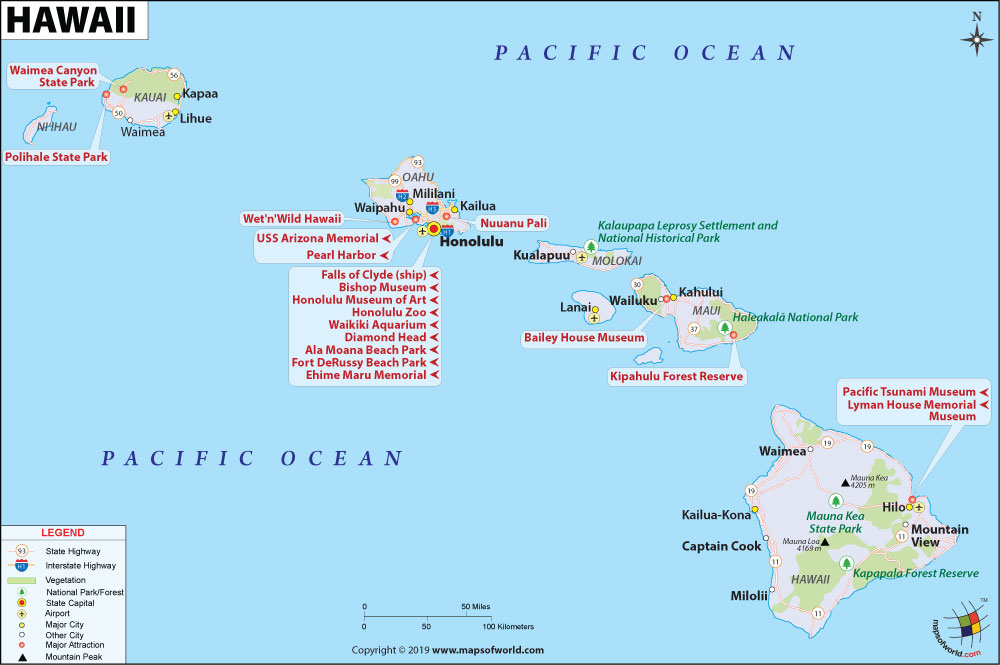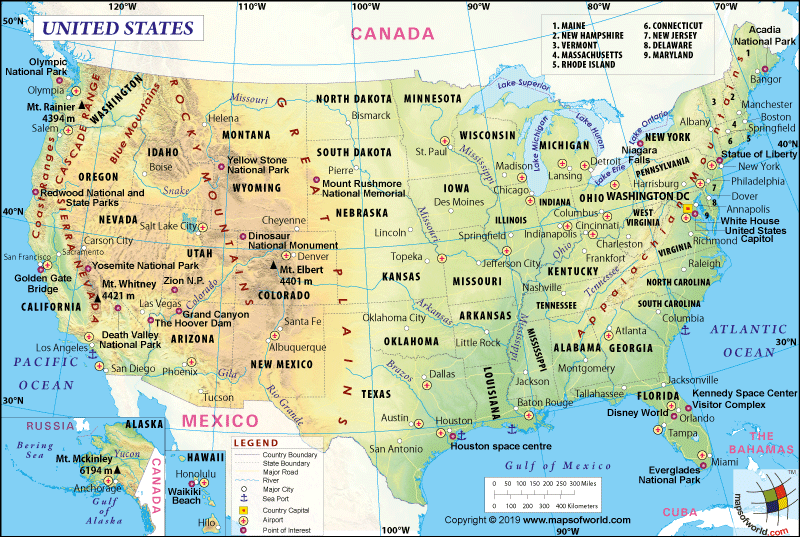What are the Key Facts of Hawaii?

|
State |
Hawaii |
|
State Capital |
Honolulu |
|
Largest City |
Honolulu |
|
Coordinates |
21°18′41″N 157°47′47″W |
|
Nickname(s) |
The Aloha State (official), Paradise of the Pacific, The Islands of Aloha |
|
Postal Abbreviation |
HI |
|
Area |
10,931 sq. mi (28,311 sq. km) |
|
Highest Point |
Mauna Kea, 13,796 ft (4,205.0 m) |
|
Number of Counties |
5 |
|
Population |
1,420,491 (2,018) |
|
Date of Entering the Union |
August 21, 1959 |
|
State Anthem |
Hawaiʻi Ponoʻī (Hawaiʻi’s Own True Sons) |
|
Governor |
David Ige (Democratic Party) |
|
Lieutenant Governor |
Josh Green (Democratic Party) |
|
U.S. Senators |
Brian Schatz (Democratic Party), Mazie Hirono (Democratic Party) |
|
U.S. House Delegation |
Senator Brian Schatz (Democratic Party), Senator Mazie Hirono (Democratic Party), Rep. Ed Case (Democratic Party, 1st district), Rep. Tulsi Gabbard (Democratic Party, 2nd district) |
|
GDP (Millions of Dollars) |
93,798 |
|
Demonym |
Hawaiian |
|
Time Zones |
UTC−10:00 (Hawaii) |
Where is Hawaii?
Hawaii is located in the Pacific Ocean and is formed entirely of islands. It is the only US state that is not part of the Northern American continent. In the Central Pacific Ocean, this state is located in the southwest of the continental US. It is around 3,850 miles (6,195 km) away from Japan and 2,390 miles (3,850 km) away from California.
Which Ocean Surrounds Hawaii?
Hawaii is surrounded by the Pacific Ocean.
What is the Geography of Hawaii?
Hawaii is spread across a total area of 10,931 sq. mi (28,311 sq. km), out of which 6,423 sq. mi (16,638 sq. km) island area and 4,507 sq. mi (11,672 sq. km) is water area. The water area occupies 41.2 % of the total area.
Hawaii is the longest island chain in the world. It is spread across a length of 1,523 miles (2,451 km). The Pacific Ocean surrounds this state along 2,400 miles (3,862 km) southwest of the Continental USA.
The state of Hawaii’s mean elevation is 3,030 ft (924 m) above sea level. While the highest elevation point is Mauna Kea at 13,796 ft (4,205 m) above sea level, the lowest elevation point is the Pacific Ocean at sea level. Besides Mauna Kea, the other significant mountains are Haleakalān Mauna Loa, Puʻu Kukui, Kawaikini, Kamakou, Kaʻala, Lānaʻihale, Hualālai, Kaunu o Kaleihoohie, etc.
The major rivers in this state are Wailuku River, Wailua River, South Fork Kaukonahua Stream, North Fork Kaukonahua Stream, Hanalei River, Kolekole Stream, North Fork Wailua River, Waimea River, Kaukonahua Stream, Anahulu River, etc. Salt Lake is the major lake in Hawaii.
Hawaii archipelago consists of 137 islands. Each of the islands is the top of a submerged volcanic mountain. These islands can be divided into three land groups.
One group consists of eight main islands that are located at the southeastern end of the archipelago. From the northwest to southeast, these islands are Niʻihau Island, Kauaʻi Island, Oʻahu Island, Molokaʻi Island, Lānaʻi Island, Kahoʻolawe Island, Maui Island, and Hawaiʻi Island (also called Big Island). Except for Kahoʻolawe Island, all these islands are inhabited. Hawaiʻi Island is the largest habitable Hawaiian island, covering 4,038 sq mi (10,458 sq km).
The other two groups include 124 islands, which are spread across 3 sq mi (8 sq km). These islands are not fit for human inhabitation. The second group comprises middle-sized isles as well as rock islets (tiny islands). There is a third group of islands that are located in the northwest section of the state. They mainly include coral and sand.
Tall cliffs rise straight up from the water’s edge in some of the coastline. Along the shore in some places, large rocks (created from lava) protrude from the sea. The white sand is found in most of the beaches. However, on some beaches, black sand can also be found. These were formed when the molten lava met the sea.
What is the Climate of Hawaii?
This oceanic American state mainly gets a tropical climate. However, four Köppen climate zones can be found here: tropical, polar, temperate, and arid. The climatic zone is dependent upon the topography or altitude on the constituent islands. Significant rainfall on the windward side takes place due to trade winds blowing towards the Hawaiian Islands’ northeastern slopes.
Microclimates including temperate, arid desert, tropical rainforest, and alpine climates are found in the eight main islands of the state, mainly because of the diverse terrain. Whether the place will be windward or leeward depends upon its relative position with the high mountains.
Hawaii has a wide range of terrain including high mountain peaks going up to 4,200 meters (13,780 ft), extensive slopes, ridges, and valleys. The place gets lots of fresh air throughout the year because of the sea air from the vast Pacific Ocean. The availability of large quantities of air doesn’t allow the temperature to reach high levels, as characterized in tropics. It is the north and eastern trade winds that keep both temperature and humidity to a moderate level.
During summer, usually, the average high temperature revolves within a high at 28.9 °C (84 °F) and low at 21.1 °C (70 °F). The high temperature during summer usually doesn’t breach 32.2 °C (90 °F). The average temperature during winter generally remains within the top at 26.1 °C (79 °F) and low at 18.3°C (65°F). Snowfall takes place only at higher altitudes such as Mauna Kea and Mauna Loa mountains.
The second highest rainfall in the world takes place in Kauai’s Mount Waialeale. The average annual rainfall here is 460 inches (11,684 mm) per year. While the dry season starts in May and continues till September, the wet season begins in October and continues till April. Thunderstorms are a more significant threat in Hawaii. Pacific hurricanes generally take place during July-December. The months from May to October (especially May and June) is the best time to visit Hawaii.
What is the Economy of Hawaii?
The total Gross Domestic Product (GDP) for Hawaii increased from US$ 65,692 million in 2009 to US$ 93,797.9 million in 2018. It ranked 40th among the US states and territories in terms of the economy size. The Median Household Income in Hawaii was US$80, 108 in 2018, an increase from US$ 55,649 in 2009. It is the 4th largest state in terms of Median Household Income.
The Per Capita, Personal Income in Hawaii, was US$ 41,352 in 2009 and it increased to US$ 55,418 in 2018. In terms of the per capita personal income, it ranks 18th in the list of US states, District of Columbia, and territories.
While tourism is the largest industry in the state, contributing around 21% of the state GDP. Reports say more than 9.4 million visitors visited Hawaii in 2017 and made expenditures of more than US$16 billion. Japanese are the largest group of inbound international travelers to Hawaii. Over 1,568,609 Japanese travelers visited this US state in 2017. Other significant industries here are sandalwood, sugarcane, whaling, education, pineapple, and military.
In 2018, the total export value of Hawaii was US$659,774,596, and the total import value was US$4,524,222,289, leading to a trade balance of -US$3,864,447,693. The main exports are Oil and Mineral Fuels, Aircraft, Iron and Steel, Seafood, Fruit and Nuts, Beverages, etc. The main import items are Oil & Mineral Fuels, Aircraft, Motor Vehicles and Parts, Electrical Machinery, Furniture, Industrial Machinery, Seafood, etc.
The unemployment rate dropped from 7.3% in June 2009 to 2.3% in October 2017. However, it has again increased to 2.6% in November 2019. A new Census Bureau estimate shows that 192,000 people in Hawaii live below the line of poverty. The average poverty rate during 2016-2018 was 13.7%.
What is the Transportation System of Hawaii?
A complex network of roads, freeways, rails, ferries, and airways comprise the Hawaii transportation system.
The major airports in the state are Daniel K. Inouye International Airport (in Honolulu, Oahu Island), Kahului Airport (in Kahului, Maui Island), Ellison Onizuka Kona International Airport at Keahole (in Kailua-Kona, Hawaii Island), Lihue Airport (in Lihue, Kauai Island), Hilo International Airport (in Hilo, Hawaii Island), Molokai Airport (in Kaunakakai, Molokai Island), Lanai Airport (in Lanai City, Lanai Island), etc.
Federal highways are there in Oʻahu only. The public bus system serves as significant roadway transport. The major bridges and tunnels are Admiral Clarey Bridge, Hospital Rock Tunnels, John H. Wilson Tunnels, Nu‘uanu Pali Tunnels, and Tetsuo Harano Tunnels.
Why Hawaii is called “The Aloha State”?
The official popular nickname (designated by the Legislature of the State in 1959) of Hawaii is “the Aloha State”. The legislature defines that the “Aloha Spirit” or the mutual regard and affection for the others is the essence of the state, leading to the collective existence of every person. That’s how Hawaii got its name.
Other nicknames of Hawaii are “The Pineapple State”, “Paradise of the Pacific”, and “The Youngest State”.
What are the Popular Tourist Attractions in Hawaii?
Waikiki Beach and Diamond Head State Monument, Pearl Harbor and USS Arizona Memorial, Hanauma Bay Nature Preserve, Hawaii Volcanoes National Park, Haleakala National Park, Waimea Canyon State Park, Na Pali Coast State Wilderness Park, Kona Coffee Living History Farm, Hana Road, Waipio Valley Lookout, Hamakua Heritage Corridor
Facts About Hawaii
1) Hawaii is nicknamed “The Aloha State“.
2). Hawaii is the 50th state of the United States of America. It attained statehood on August 20, 1959.
3) The state of Hawaii features the maximum density of population in the U.S.
4) Hawaii is the state with the maximum width in the United States.
5) The state of Hawaii is the remotest place on earth.
6) Hawaii forms the most extensive chain of islands in the world.
7) The maximum temperature recorded in the state was 100° F or 37.8° C, calculated in Pahala in 1931. The lowest temperature documented in the state was 12° F or -11.1° C, calculated on Mauna Kea in 1979.
8) The alphabet of Hawaii includes just 12 letters:
- Consonants: H, K, L, M, N, P, W
- Vowels: A, E, I, O, U
9) Hawaii is the sole state in the United States to produce coffee. Coffee estates in the state cover more than 6,200 acres of land. In 2003, the amount of coffee production was 8.5 million pounds.
10) Hawaii is a major pineapple producer in the country.
11) The capital of the state is Honolulu.
12) The official flower is the Yellow Hibiscus.
13) The official song is Hawaii Ponoi.
14) The official bird is the Nene or Hawaiian Goose.
15) The official mammal is the Humpback Whale.
16) The official tree is the Kukui or Candlenut.
17) The state is made up of eight big islands and they are Kauai, Niihau, Molokai, Oahu, Maui, Lanai, Hawaii or the Big Island, and Kahoolawe.
18) Iolani Palace is the sole imperial palace in the country. It is situated on Oahu Island.
19) The first Asian-American to be elected to the U.S. Senate was Hiram Fong of this state.
20) Hawaii is the most culturally diverse state in the United States.
Related Links:



![]()
